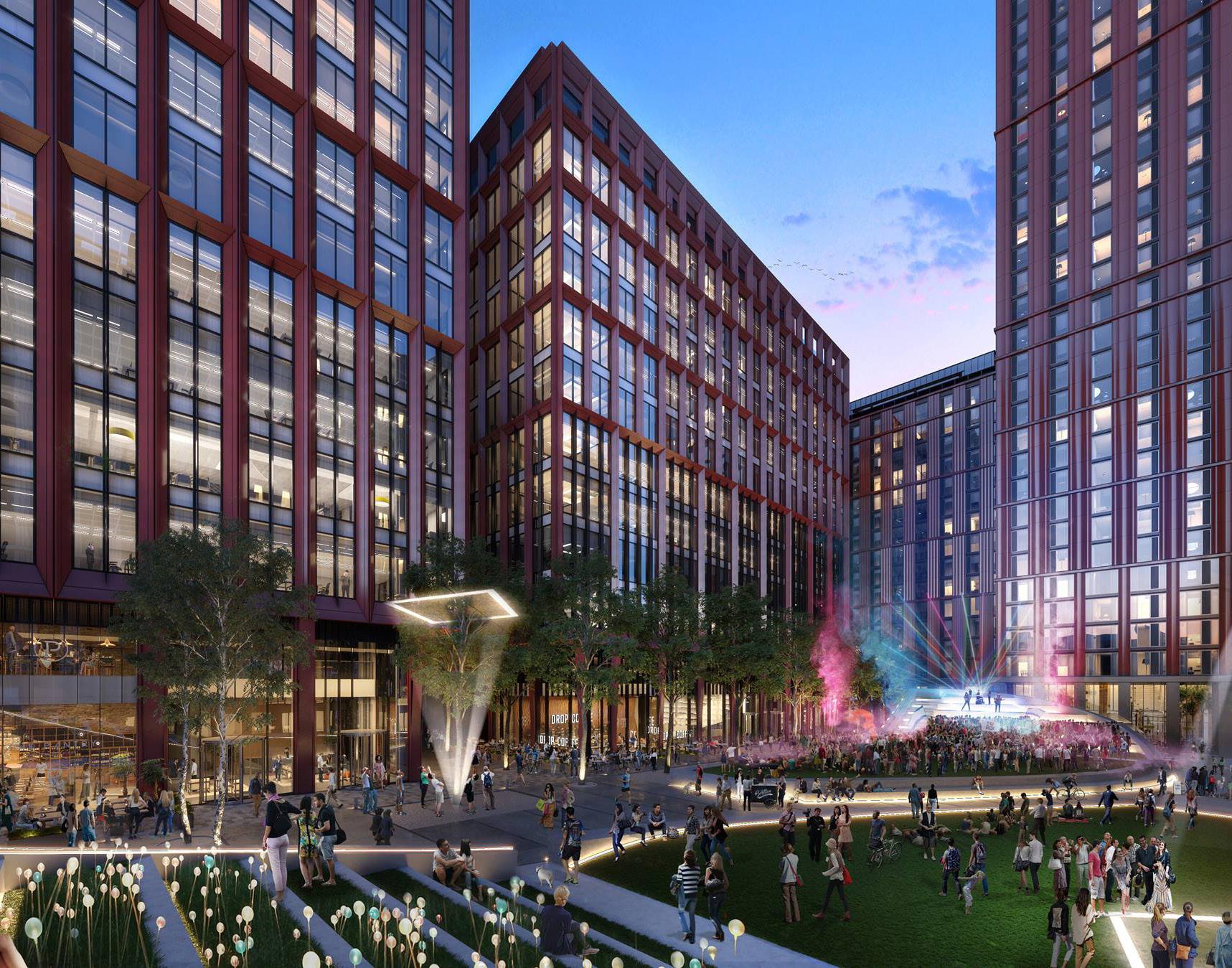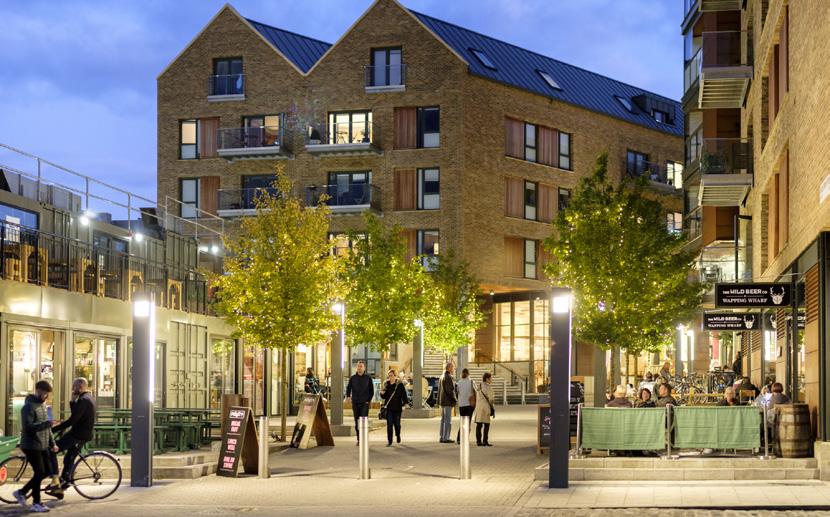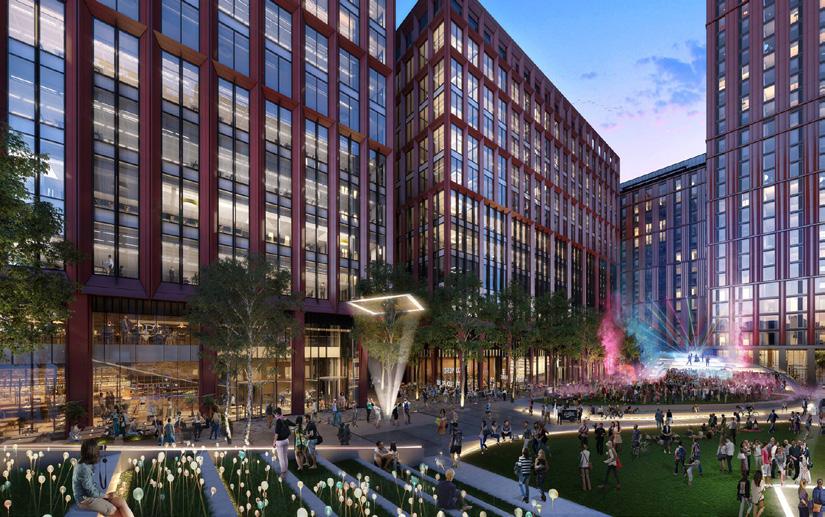
11 minute read
Feature: Mixed-use development
Wapping Wharf - Bristol
Wood Wharf - London
HOW HAVE MIXED-USE DEVELOPMENTS CHANGED UK CITIES?
Mixed-use developments are becoming prominent and increasingly iconic parts of cities across the UK – but how are they different? Are they having a positive impact and what does the future hold for them? Business Leader investigates.

With ongoing issues affecting the high street, affordable housing and the environment – could mixed-use developments provide solutions to these challenges? In the UK, these developments are creating ‘destinations’, improving the local economy and repurposing abandoned or disused areas into urban, multi-purpose districts. What are mixed-use developments? The idea can be summarised as destinations predominantly found outside city centres, where retail, working and housing environments are all set within the same development. However, an increasing number of these are regenerating city centres too. With the hyper-competitive clamour for premium
development spaces across the country, mixed-use has been hailed as the perfect alternative to purely retail or housing developments – and with the ongoing difficulties each industry is facing, this type of
development can create an ecosystem where retail, working spaces and housing can support each other.
As demand grows for space in cities across the UK, local government, developers and retailers are working together to create the future of urban developments. The residential aspect of mixed-use developments is the main value driver. By getting the right mix of retail, restaurants and repurposed land, the value of properties can be drastically increased. When compared to traditional city centres and high streets, where retail-heavy areas are going through major challenges, a mixed-use development provides an experiential environment for people to live, work and be entertained.
Stuart Hatton is the Managing Director of Umberslade, the developer behind Bristol’s Wapping Wharf, a mixed-use regeneration scheme that has transformed the harbourside area in the city. He said: “Residentially-led mixed-use development is all about creating places people want to be. At Wapping Wharf, it’s been integral to our approach in creating this thriving new neighbourhood of homes, shops, eateries and other businesses. In the early stages, I sat down and thought: If I lived here, what would I want on my doorstep?” Many developers have also turned mixeduse into a way of not only getting planning permission for larger or higher quality homes – but also a way to increase the value of them and the surrounding area. What benefits do they provide? It is the experiential factor that has really led to the explosion of developments across the UK – as the modern retail consumer demands more from their shopping experience.
Stuart Hatton
In any business, if you are not providing the market with what it wants then you won’t last long. This can be seen happening on many high streets, where retail premises that are not fit for purpose are either vacant or are being repurposed for uses other than retail such as offices and residential. People still like shopping, but rather than simply making a purchase, they want to have an overall shopping experience that is enjoyable and engaging from start to finish. Therefore, a welcoming retail environment is essential.
Nick Turk, Director in the Retail Agency Out-of-Town team at Colliers International, comments: “People don’t want a shopping trip that begins with having to pay to park somewhere that feels overpriced, dingy and threatening. They want to be able to shop in a place where they can also have a decent coffee and good food, or take the kids to a soft play, or have aspirational experiences such as sampling perfumes in a stylish cosmetics area. “Mixed-use is repurposing retail for the modern market, and is offering a more experiential way of shopping that appeals to today’s consumer. Mixed-use meets the desire of modern shoppers to go beyond the transactional to the experiential.” However, the benefits are not just limited to the desires of the experiential shopper. Chris Pickup, Associate Director at national planning and development consultancy Turley, comments: “The benefits of encouraging the diversification of uses in town centres is that they can help to bring residential uses back into centres, provide development land in sustainable and accessible locations particularly around transport hubs, they can be multi-generational and healthy places to live and can also be the focal point for public and private sector investment. “Mixed-use centres benefit from increased footfall and expenditure, which create consumer markets for retail, services, food and beverage and leisure activities which
can strengthen the overall economies and health of town centres. Town centres with strong economies, services and activities can be attractive for multiple generations and more appealing for people to live, work and spend their leisure time within central locations. “In order to have a future place in the shopping hierarchy, many traditional retail destinations will need to become multipurpose destinations that combine retail, leisure and eating out into their tenant lineups in order to attract additional customers and achieve sustainable economic growth. These trends confirm that diversification and the attraction of a mix of uses (in addition to retail) are necessary if traditional town centres are to achieve a viable and sustainable future.” And the positive environmental impact of mixed-use has created a strong desire from developers and local government to make these destinations more commonplace in the UK.
Yuli Cadney-Toh, Architect Director at international architectural firm BDP, comments: “Mixed-use also has the potential to drastically reduce our reliance on transport, because you can live, work, learn, shop and enjoy your leisure time all within your neighbourhood or within walking or cycling distance. In simplest terms, mixed-use gives agency back to people – they can have far greater influence over purpose of urban space, which in turn is opening up new design possibilities and ultimately will transform the look and feel of our towns and country.” Impact on retail It is clear that mixed-use developments are filling a gap left in the wake of the current housing and high street struggles. However they are also providing solutions to some of the UK’s wider societal issues. Turk comments: “Mixed-use is solving many issues because there is too much retail space in the UK – especially in high streets and shopping centres. In order to attract shoppers it is vital to move beyond purely retail space and instead create desirable destinations which have attractions other than just retail.
Cont.
“Mixed-use centres will provide some solutions to these problems. Some properties are simply not suitable but can be re-purposed to other uses. This is especially true of retail warehouses which – despite being the most resilient retail sector given their ability to work well with online shopping and free parking etc – can be attractive for residential and last-mile delivery uses because they are well located and easy to repurpose.” Once, a trip to the city centre was all about shopping, but as e-commerce continues to grow and retailers reassess their use of space, city centres are offering a more diverse mix of amenities that better cater for modern urban lifestyles.
Nick Turk
In the past few years, many British retail institutions have gone out of business – with plenty more in deep financial troubles. However, this has opened the door for fresh offerings from local and smaller businesses. Rebirth of the high street This rejuvenation of city centres and disused areas has had the knock-on affect of giving a new lease of life to the high street. Also, with retail habits evolving and the influence of millennials wanting destinations to live, work and be entertained – the future looks a lot brighter. Also, as smart city applications become increasingly desired it will become easier to analyse and implement technologies to make our immediate environment more appealing to residents and increase footfall to the area. Mixed-use developments are under construction across all major cities throughout the UK – and are already complementing the current developments open to the public – meaning many regions have seen a rebirth. However, more needs to be done. Pickup comments: “The state of the existing retail market stresses the importance of being able to find new ways of retailing and alternative land uses to be developed within town centres to keep them vital and viable destinations. Planning policy can move at a slow pace and often takes a while to react to changing market conditions. Some councils have policies in place which prevent the loss of A1 retail floorspace and restrict alternative mixed-uses from being the focus within town centres – this needs to change in order for centres to adapt to what is happening in the market.
“In order to attract more shoppers and generate additional footfall, it has become necessary for operators and owners of town centre assets to provide a more interesting and varied experience so that consumers can enjoy a full day out or a shopping trip extended by leisure and dining.
"Increasingly, it has become necessary to incorporate broader leisure facilities to act as additional attractions and backfill space left vacant by failed retailers. This has led to a growth in facilities such as cinemas, bowling alleys, trampoline centres, mini-golf and 24-hour gyms, and other varied leisure activities within town centre locations, which previously would have been occupied solely by traditional retail operators.”
Refashioning areas of independent retail or housing to city
neighbourhoods will transform housing, leisure and working environments for the better – as it meets the needs for the modern person living in a city.

Yuli Cadney-Toh
Simon Peacock, Lead Director at real estate advisors JLL in the South West, comments: "The location of old department stores and large shops are often ideal for other uses such as much-needed homes, offices, hotels, restaurants, cafes or bars.
"Our city and town centres need to become places for people to live, work, shop, eat and relax, adding diversity and bringing people in. A mixed-use approach is the direction of travel, signifying the end of an era where urban areas were zoned according to use.”
What does the future hold? In the future, town centres will be tech-rich destinations for mixed-use purposes, that reinvent transport and retail hubs.
By delivering an ‘experience’ rather than having these diverse components acting alone – as well as new creative uses for mis-used spaces – cities can flourish in a modern world.
Cadney-Toh comments: “The problem-solving potential of mixed-use is actually much wider than the property and retail industry – helping cities and towns to transform, in everything from more homes, to community building, to placemaking and meaning for the new high street, and addressing climate change by multiuse of buildings to reducing our reliance on cars.
“Mixed-use demand has come out of the people exercising greater agency to influence, but this is a challenge for the industry to deliver, which is where technology comes in. We are in a period of generational transition. Societies and cities that embrace this flexible, dynamic-based model will have the edge over those that are slower to change.”
Pickup concludes: “If you invest in mixeduse town centre development, councils and developers are going to get more benefits than the initial investment in terms of spin-off benefits generated for local businesses and town centres as a whole.
“The model quantifies additional expenditure generated by occupants, visitors and workers of mixed uses, including residential development, hotels, office and retail and leisure floorspace and calculates positive economic impacts. The outputs include jobs, wages, locally-available expenditure and discretionary spend to support existing or new town centre businesses.”
woodwharf.com

Having already created one of the largest business districts in Europe, Canary Wharf Group is continuing to evolve London’s former docks site by redeveloping a 23-acre site into five million sq ft of mixed-use space. A sense of community, education and culture are at the heart of these plans, which include two million sq ft dedicated to fast-growth businesses. Wood Wharf will attract a larger number of tech jobs than the entire city of Cambridge.

wappingwharf.co.uk

Based on the harbourside in the city centre, Wapping Wharf is built on a former shipyard and dry dock. However, in 2003, Umberslade purchased it and kicked off the revitalisation of the entire area of the city. Home to its famous eateries and independent retailers – built in old shipping containers – as well as luxury retail and office space, this area has become a new focal point for Bristol.
circlesquaremanchester.com

Circle Square is a new neighbourhood that will stand in the place of the former BBC site at the heart of Manchester. It will be delivered in three phases, with nearly two thirds in place by the end of 2020, including over 1,000 new homes, 400,000 sq ft offices, multi-storey car park, hotel, shops, restaurants, bars and more.










